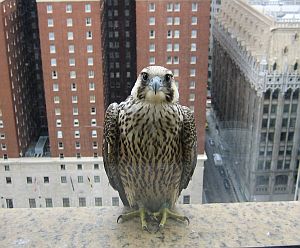 Several people have asked me why birds of prey, especially red-tailed hawks and peregrines, would choose to nest close to humans. Isn’t it unnatural? Doesn’t it make them tame? Are the ones who nest on buildings already tame?
Several people have asked me why birds of prey, especially red-tailed hawks and peregrines, would choose to nest close to humans. Isn’t it unnatural? Doesn’t it make them tame? Are the ones who nest on buildings already tame?
In the case of peregrines, whom I know better than red-tails, I can tell you it never makes them tame. To them, we are still their mortal enemies. Instead, conscious or not they have made a calculation: The enemy of my enemy is my friend… and besides, there’s lots to eat.
Birds of prey know that humans can and do hurt them but they also know from personal experience that it is rare. Meanwhile, they have learned there’s an advantage in being near humans because we keep their other enemies away.
A good example is that great-horned owls, a dangerous predator of peregrines, are rarely if ever found on office buildings. Peregrines who nest on buildings have one less worry as they raise their young.
Another advantage is the food we generate. Humans create a lot of garbage and many prey species eat it. For red-tailed hawks, we indirectly provide rodents. For peregrines, our buildings house pigeons and starlings, a ready food supply.
When their nests are successful their hunch about us is reinforced. The juvenile peregrine in the picture is a case in point. She was born in downtown Pittsburgh on the Gulf Tower in April 2007. Her parents made the calculation that the territory was safe with plentiful food and they successfully raised four young birds. As you can see, she was thriving last July when her picture was taken by Matt Frederick as she perched on Roberto Capriotti’s windowsill at K&L Gates in the Oliver Building.
If these birds can put up with seeing humans every day, the rest is easy.
p.s. I wish she’d landed on my windowsill… but if she had, I would have been unable to concentrate for the rest of the day!
(photo by Matt Frederick)
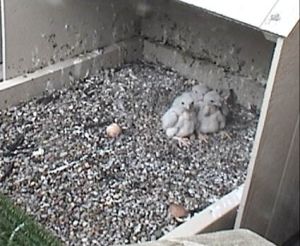 I captured this photo on the Pitt peregrine webcam today and my first reaction was “They’re soooo cute!”
I captured this photo on the Pitt peregrine webcam today and my first reaction was “They’re soooo cute!” 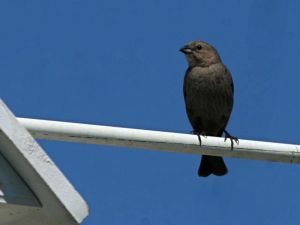 My friends will tell you this bird is a villain, a despoiler of songbird nests, a wrecker of warbler home life. She refuses to raise her own young, foisting them off on unsuspecting foster mothers. To make matters worse, she sneaks in and kills the foster mother’s own young so that hers have a better chance to grow up.
My friends will tell you this bird is a villain, a despoiler of songbird nests, a wrecker of warbler home life. She refuses to raise her own young, foisting them off on unsuspecting foster mothers. To make matters worse, she sneaks in and kills the foster mother’s own young so that hers have a better chance to grow up.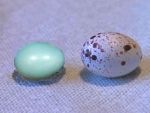
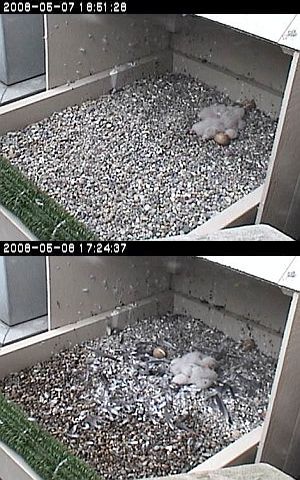 I’ve watched the peregrines at University of Pittsburgh for many years and have learned something about Dorothy the female who nests there: she is not the best of housekeepers. When she has chicks to feed, cleaning her nest is a low priority.
I’ve watched the peregrines at University of Pittsburgh for many years and have learned something about Dorothy the female who nests there: she is not the best of housekeepers. When she has chicks to feed, cleaning her nest is a low priority.
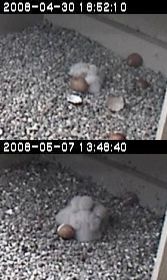 It’s been a week since 3 peregrine eggs hatched at the University of Pittsburgh and their parents have been feeding them frequently.
It’s been a week since 3 peregrine eggs hatched at the University of Pittsburgh and their parents have been feeding them frequently.  Several people have asked me why birds of prey, especially red-tailed hawks and peregrines, would choose to nest close to humans. Isn’t it unnatural? Doesn’t it make them tame? Are the ones who nest on buildings already tame?
Several people have asked me why birds of prey, especially red-tailed hawks and peregrines, would choose to nest close to humans. Isn’t it unnatural? Doesn’t it make them tame? Are the ones who nest on buildings already tame?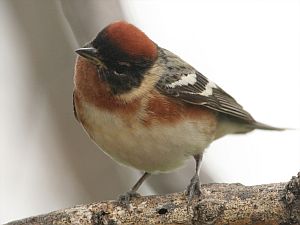 For a peregrine fanatic this is a hard time to be away from Pittsburgh – what with baby peregrines in two nests and lots to watch – but migration is in full swing and the warblers beckon. There are lots of birds flying north, birds who barely stop to eat on their way to Canada, and I don’t want to miss them.
For a peregrine fanatic this is a hard time to be away from Pittsburgh – what with baby peregrines in two nests and lots to watch – but migration is in full swing and the warblers beckon. There are lots of birds flying north, birds who barely stop to eat on their way to Canada, and I don’t want to miss them.